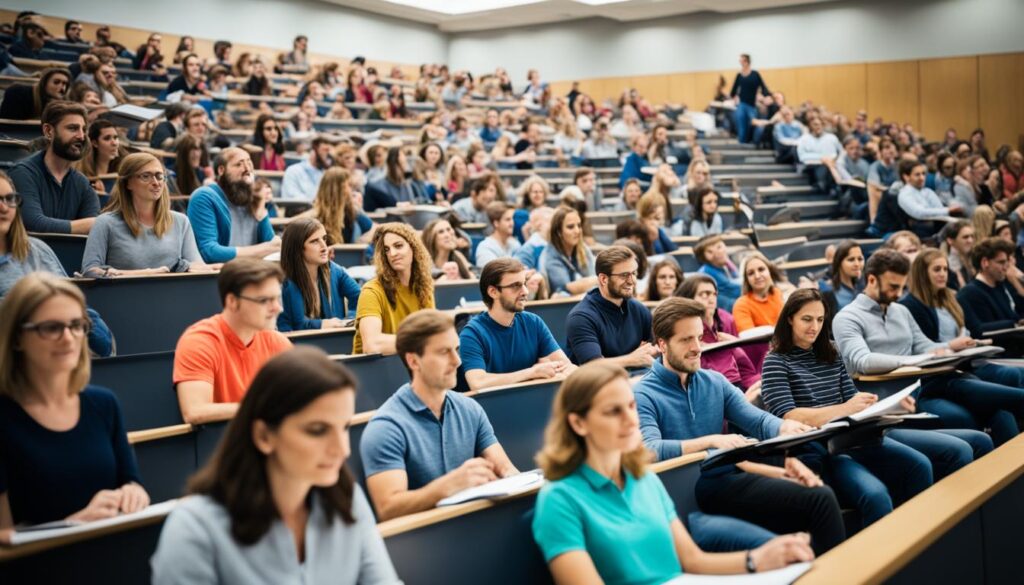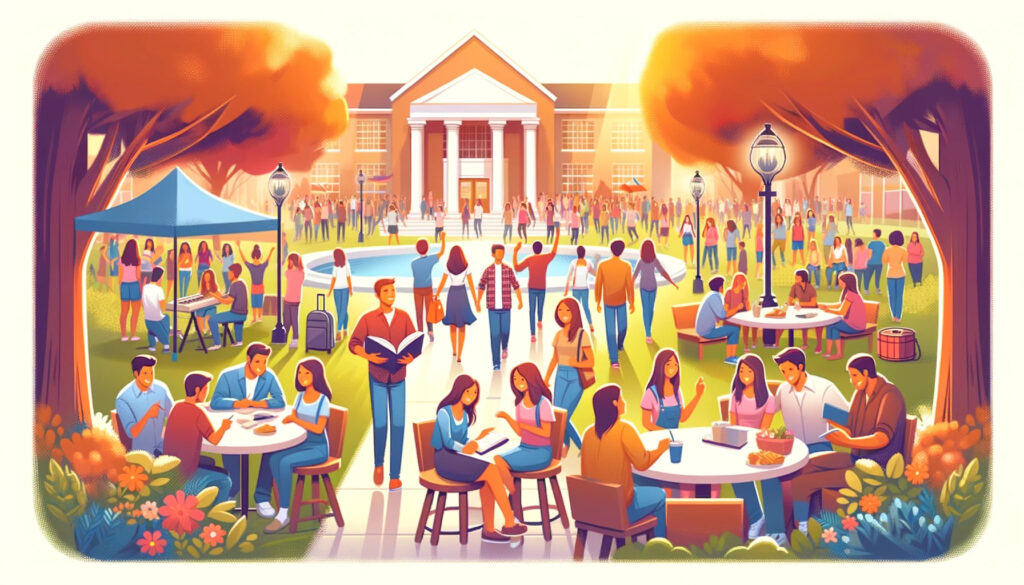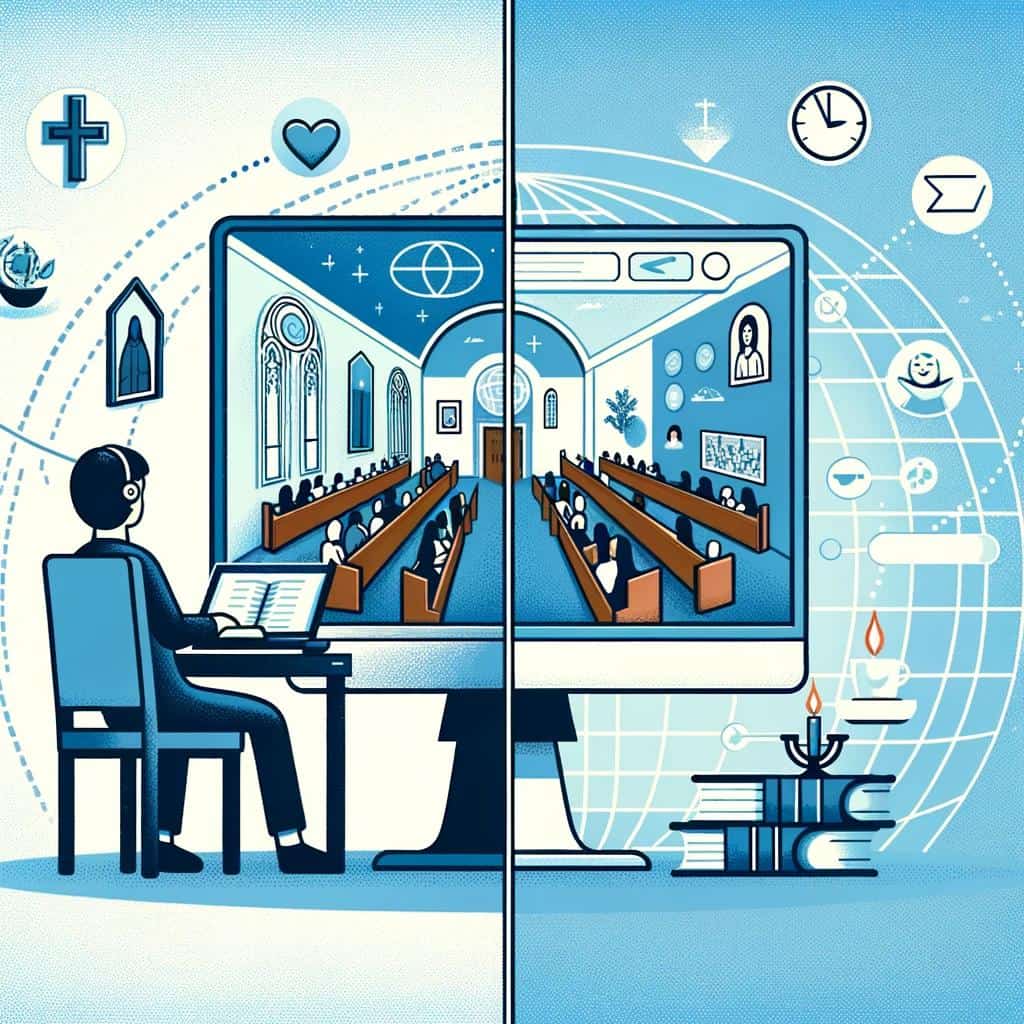When you start looking for colleges, pay close attention to the student-to-faculty ratio. It’s more than just a number. It shows how your education will be shaped. For those starting college, this ratio tells how much personal interaction you’ll get and the type of academic community you’ll join. A low ratio usually means more one-on-one time and is key for both learning and personal growth at smaller schools.
Key Takeaways
- The student-to-faculty ratio is a vital statistic in the college search for prospective students.
- A lower ratio is indicative of a college offering a more personalized education.
- Undergraduate students can expect higher quality attention and mentorship in colleges with favorable ratios.
- This ratio is influential in fostering an engaging academic environment and close-knit community.
- As part of choosing the right college, this ratio offers insight into class sizes and the nature of student-faculty interactions.
Understanding the Student-to-Faculty Ratio and Its Impact on Education
The student-to-faculty ratio is crucial for judging educational quality in higher education. It greatly influences the learning environment and academic results at colleges. This ratio indicates class sizes and how much attention each student gets.
The Definition and Calculation of Student-to-Faculty Ratio
This statistic is key for future students. It shows how many students are taught by each faculty member. A low ratio, like Dartmouth College’s 8-to-1, means more interaction and mentorship. Larger schools tend to have higher ratios.
What the Ratio Indicates About Academic Environment
A low student-to-faculty ratio means smaller classes and more personal attention. This setup boosts student involvement and support. Dartmouth College, for instance, has classes of about 15 students for better discussion.
Comparing Ratios: Public Schools vs. Private Colleges
Public and private colleges often differ in their student-to-faculty ratios. Public colleges usually have a higher ratio because of their big enrollments. This makes giving personal attention harder. Private colleges tend to have smaller classes, offering a closer-knit atmosphere.
| College Type | Student-to-Faculty Ratio | Average Class Size |
|---|---|---|
| Public College | 20:1 | Varies widely |
| Private Institution | 9:1 | Smaller classes ( |
| Dartmouth College (Private) | 8:1 | Approx. 15 students |
| Harvard University (Private) | 6:1 | Dependent on department |
That’s why knowing the student-to-faculty ratio is key when choosing a college. Whether you’re looking at national statistics or direct college reports, this knowledge helps ensure you get the education that fits you best.
Benefits of a Low Student-to-Faculty Ratio in Colleges
When you start your college search, look beyond the college’s reputation. Consider the benefits of small class sizes and personalized education. A low student-to-faculty ratio makes your college experience better. It creates a supportive environment that helps you succeed.
Enhanced One-on-One Attention from Faculty Members
With a low ratio, professors have more time for you. They are easier to reach and ready to help with your growth. For example, Great Lakes Christian College has a 12:1 ratio. This shows how students can get a better education in such settings.
Increased Engagement and Participation in Small Classes
Smaller classes make learning more interactive. You can talk more, ask questions, and get immediate feedback. This improves your learning and makes you more confident in discussions. This is key for success in any career.

Bolstering Academic Performance and Support
Research shows that students do better academically with a low student-to-faculty ratio. They get more personalized help and support. This addresses your specific needs and goals.
| Comparison | Large Universities (~20:1 Ratio) | Small Colleges (~9:1 Ratio) |
|---|---|---|
| Class Size | Larger classes, less personal attention | Smaller, more intimate classes |
| Faculty Accessibility | Less availability for one-on-one interaction | Greater availability for personal interactions |
| Learning Environment | Less personalized, often lecture-based | Highly personalized, often discussion-based |
| Community Feeling | More competitive and impersonal | Close-knit, supportive community |
| Opportunities for Mentorship | More reliant on teaching assistants | Direct mentorship from experienced faculty |
Choosing a college with a low student-to-faculty ratio is smart. It not only boosts your grades but enhances your whole college experience. You’ll enjoy closer relationships, better understanding, and strong support. These are vital for doing well in the demanding world of higher education.
Analyzing Class Size: From High School to Higher Education
Classroom dynamics have changed a lot, especially after COVID-19. The move from big lecture halls to smaller groups or online classes has made learning more individual. This has encouraged a more personal way of learning.
The Shift in Classroom Dynamics Post-COVID-19
Schools and universities quickly moved to online classes and smaller groups due to the pandemic. This shift did more than address health worries. It started a new phase in teaching methods. It showed how flexible and strong our educational systems can be.
From Lecture Halls to Small Group Discussions
Smaller classes are becoming more common. At least 24 states have started programs to reduce class sizes. This move to smaller groups aims to focus more on each student’s needs.
With fewer students in class, there’s more chance to talk with teachers and be involved. This improves learning for everyone. It’s important in both high schools and colleges.
| Institution | Student-to-Faculty Ratio | Average Class Size |
|---|---|---|
| Princeton University | 5-to-1 | Approx. 12 |
| MIT | 3-to-1 | Varies, generally small |
| University of Central Florida | 30-to-1 | Larger, varies |
| Caltech | 3-to-1 | Less than 20 in 69% of classes |
| Harvard University | 5-to-1 | Median size 12 |
The focus on the right class size is key to good education. Smaller groups show they help students do better and be more active. This matters even more as schools balance online and face-to-face classes now.
Why Should You Care About Student-to-Faculty Ratio When Choosing a College?
When looking for a college, it’s key to know the student-to-faculty ratio. This factor deeply influences your education quality. A low ratio means you’ll likely get into smaller classes. This creates a better learning setting.
This ratio informs your chances to connect deeply with both professors and classmates. It shapes your research chances and class participation. So, it’s vital in picking a college that meets your learning goals.
| Feature | Benefits |
|---|---|
| More individual attention | Instructors can tailor feedback and support to individual student needs. |
| Enhanced participation | Smaller classes allow more students to engage actively in discussions. |
| Stronger relationships | Students can build closer connections with faculty and classmates, enhancing their learning and networking opportunities. |
| Greater accountability | With fewer students, professors can ensure that each student comprehends the material, boosting overall academic success. |
At SUNY Fredonia, the student-to-faculty ratio is 12-to-1, with class sizes around 22. This means a very personal academic path. Here, you are known by your name and goals, not just as a number.
This tight educational setup promotes not just academic success but also personal and career growth. Keep these points in mind during your college search. They will guide you to a school where you can excel in all aspects.
The Influence of Student Ratios on College Resources and Opportunities
As you look into colleges, it’s key to grasp how student-to-faculty ratios impact academics and resources. This ratio shapes class size and professor attention. Plus, it dictates the range and quality of both academic and fun extracurricular opportunities. A smaller ratio means a more tailored learning journey. And a bigger ratio hints at more diverse activities and programs.
A Closer Look at Access to Academic and Extracurricular Activities
Top colleges like Yale and Caltech, with their great ratios, offer a strong academic scene. The chance to learn in smaller classes means you can really connect with teachers. It boosts active participation. On the flip side, bigger schools like Oregon State University, with an 18-to-1 ratio, provide lots of extracurriculars. This variety supports many interests and helps grow different skills outside class.
Understanding Resource Allocation in Relation to Ratio
How a school divides its resources is vital for a good study and extracurricular balance. At places with fewer students per teacher, resources are richer. This often leads to better facilities, more teachers, and smaller, engaging classes. But in larger universities with higher ratios, resources like big event spaces or clubs are plentiful. Yet, personal attention from professors might be less.
- Williams College, with a 6-to-1 ratio, focuses on an intimate learning vibe.
- Columbia University ensures even large classes keep a small feel, with 82% of classes having under 20 students.
Thinking about the student-to-faculty ratio is crucial when picking a college. It influences your day-to-day studies and your chance to dive into different activities. Choosing a place that carefully allocates resources can boost both your academic and social experiences. It gets you ready with the knowledge and skills you’ll need later on.
Evaluating Average Student-to-Faculty Ratios Across United States Colleges
When picking a college, many students and their families look at things like acceptance rates and grad stats. Yet, the student-to-faculty ratio is super important. It greatly affects how much attention you get and the quality of your education. The national average ratio in the U.S. is 18:1. This number helps compare different colleges, like private ones, public universities, and liberal arts colleges.
National Center and U.S. News Statistics on Average Ratios
Sites like the National Center for Education Statistics and U.S. News offer deep insights into student-to-faculty ratios. These ratios show how likely you are to get personal time with your teachers. They also affect the overall quality of education. U.S. News keeps updating their rankings and reports. This helps us stay current on how these ratios change in higher education.
Diversity of Ratios Among Different College Types
Different kinds of schools have very different ratios. Liberal arts colleges often have smaller ratios. This means classes are smaller and you can get more involved. On the other hand, big public universities have larger ratios because they have more students. Private colleges’ ratios can really vary. Some keep their ratios low to give a more personalized education, which is shown in their tough acceptance rates.
| Institution Type | Student-to-Faculty Ratio | Acceptance Rate |
|---|---|---|
| California Institute of Technology | 3:1 | Less than 30% |
| Liberal Arts Colleges (Average) | Varies, often lower than 10:1 | Varies |
| Public Universities (Large) | Often higher, around 20:1 | Varies |
| Research Universities (Average) | 30:1 to 6000:1 | Depends on department and funding |
| Morehouse College (HBCU) | 10:1 | 60% |
Finally, knowing the student-to-faculty ratio is key for students in the U.S. looking for the right college. Whether you want the tight community of a liberal arts college or the wider options of a large university, these ratios tell you a lot about the school’s academic and social vibes.
How Small Class Sizes Benefit Specific Student Groups
Specific groups like minority, low-income, and students with learning issues gain a lot from small classes. These environments allow for personal attention. This makes it possible for teachers to meet each student’s unique needs.
Targeted Advantages for Low-Income and Minority Students
Smaller classes can be a huge benefit for low-income and minority students. Studies show these students do better in smaller classes. They get higher grades and do better on tests for college entry. Also, smaller classes help teachers better understand and address cultural and economic challenges.
Supporting Students with Learning Challenges Through Smaller Classes
Students with learning difficulties thrive in smaller classes. Teachers can use special teaching methods that fit different learning needs. This helps every student do well. It also makes students more interested in learning. They feel better supported than in larger classes.
| Benefits | Small Class (15:1) | Large Class (150:1) |
|---|---|---|
| Teacher Observation | Frequent, detailed | Sparse, generalized |
| Participation Opportunities | High | Low |
| Customized Instruction | Standard practice | Rarely feasible |
| Feedback Quality | Individualized, impactful | Generic, less effective |
| Engagement Levels | Increased, meaningful | Decreased, superficial |
The benefits of small classes are clear. They especially help minority, low-income students, and those with learning challenges. Small classes improve academic results. They create a better environment for every student’s success.
Financial Aid and Its Relationship to Student-to-Faculty Ratios
When looking at colleges, it’s key to see how a low student-faculty ratio affects your financial aid. Schools with lower ratios often offer better student support and more personalized learning. This can lead to greater financial aid options.
Exploring How Low Ratios Can Affect Financial Aid Options
Financial aid is often more available in schools focusing on individual student needs, thanks to low student-to-faculty ratios. Colleges with fewer students per teacher might offer more scholarships and funds. This makes learning better and helps lower costs for students and their families.
Lower Ratio and Its Impact on Graduate School Funding
For grad school hopefuls, the student-faculty ratio is crucial in finding funding. Places like MIT and Stanford have low ratios and offer lots of support with fellowships and grants. With smaller classes, faculty can help students get these funds.
| Institution | Student-to-Faculty Ratio | Graduation Rate | Acceptance Rate | Enrollment Numbers |
|---|---|---|---|---|
| Harvard University | 7:1 | 98% | 5% | 30,391 |
| Massachusetts Institute of Technology (MIT) | 5:1 | 96% | 7% | 11,254 |
| Stanford University | 5:1 | 95% | 5% | 15,953 |
| New York University (NYU) | 9:1 | 88% | 21% | 52,775 |
| University of California, Los Angeles (UCLA) | 18:1 | 91% | 14% | 44,589 |
This table shows different student-faculty ratios at well-known schools. It shows how these ratios influence the learning environment and financial aid options.
Conclusion
Choosing a college is a big step. It’s important to consider how many students there are per teacher. This ratio affects your education quality. From small to large colleges, each offers something unique.
More than half of students think about changing their major. It’s important to choose a school that supports you. Community colleges and technical schools are good for starting. Large universities offer more options but may cost more. Remember to think about living costs and financial aid too.
Your college experience is also about growing as a person. The student-to-faculty ratio shapes your chances and the community you’ll be part of. Small schools offer close connections with teachers. Big schools provide many perspectives and networking opportunities. Pick a school that matches your goals and who you are. This way, your college years will be successful and fulfilling.
FAQ
What exactly is a student-to-faculty ratio, and how is it calculated?
The student-to-faculty ratio shows how many students there are per full-time teacher. It’s found by dividing the total student number by the full-time faculty count. This measure helps us see if a school offers close interactions and small classes, which shape its academic feel.
How does the student-to-faculty ratio affect a college’s academic environment?
A lower ratio usually means smaller classes. This allows for a close learning setting where students get more individualized help and mentorship. It also shows a college’s dedication to quality education.
What are the differences in student-to-faculty ratios between public schools and private colleges?
Public schools often have bigger student-to-faculty ratios, leading to larger classes. In contrast, private colleges tend to have smaller classes and lower ratios. This provides a more personalized learning experience.
Why are smaller class sizes and a lower student-to-faculty ratio beneficial for students?
Smaller classes and low ratios create a more active and engaging learning space. They enable more class participation, focused attention, and direct help from teachers. This boosts grades and student happiness.
How have classroom dynamics changed in higher education since the COVID-19 pandemic?
Since COVID-19, there’s been a boost in online classes and smaller in-person ones for safety. This change highlights the value of adaptable learning spaces and the benefits of smaller classes, like more focused group talks and attention.
When choosing a college, why should I consider the student-to-faculty ratio?
Considering the student-to-faculty ratio is crucial because it affects your college life. It influences how much personal attention you’ll get, the classroom atmosphere, and available resources. This helps you see if a college matches your learning needs.
How does a college’s student-to-faculty ratio influence the resources and opportunities available to students?
A lower ratio often means more resources for each student. This leads to more access to classes and activities, personal learning chances, and mentorship. On the other hand, a higher ratio may mean less individual focus but more program options and activities.
What are the average student-to-faculty ratios at U.S. colleges, and why do they vary?
U.S. colleges usually have an 18:1 student-to-faculty ratio. But, this number changes a lot depending on the school. Small liberal arts colleges often have lower ratios for personal learning, while big public universities might have higher ratios due to more programs and students.
In what ways do small class sizes benefit specific groups of students, like low-income or minority students?
Small classes give extra help and attention that’s crucial for low-income, minority, and learning-challenged students. Such support boosts engagement, behavior, and results. This leads to higher graduation rates for these students.
How can a college’s student-to-faculty ratio affect financial aid and funding for graduate school?
Colleges with lower ratios might offer more financial aid per student. This often means better aid packages, scholarships, and graduate funding. A low ratio shows a college’s commitment to its students’ success and support.







